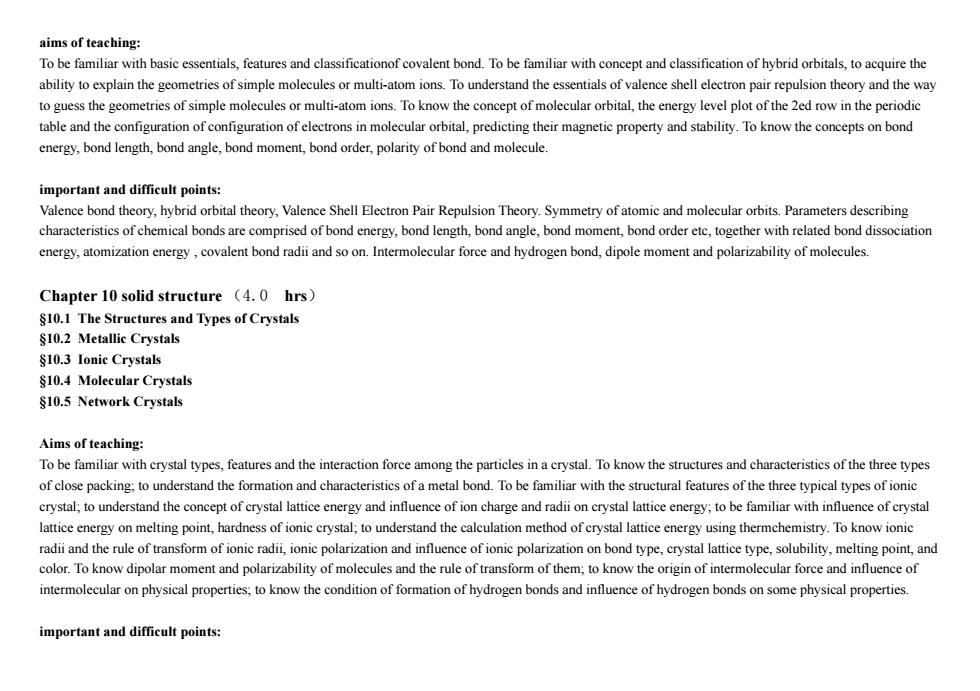正在加载图片...

aims of teaching: To be familiar with basic essentials,features and classificationof covalent bond.To be familiar with concept and classification of hybrid orbitals,to acquire the ability to explain the geometries of simple molecules or multi-atom ions.To understand the essentials of valence shell electron pair repulsion theory and the way to guess the geometries of simple molecules or multi-atom ions.To know the concept of molecular orbital,the energy level plot of the 2ed row in the periodic table and the configuration of configuration of electrons in molecular orbital,predicting their magnetic property and stability.To know the concepts on bond energy,bond length,bond angle,bond moment,bond order,polarity of bond and molecule. important and difficult points: Valence bond theory,hybrid orbital theory,Valence Shell Electron Pair Repulsion Theory.Symmetry of atomic and molecular orbits.Parameters describing characteristics of chemical bonds are comprised of bond energy,bond length,bond angle,bond moment,bond order etc,together with related bond dissociation energy,atomization energy,covalent bond radii and so on.Intermolecular force and hydrogen bond,dipole moment and polarizability of molecules. Chapter 10 solid structure (4.0 hrs) $10.1 The Structures and Types of Crystals $10.2 Metallic Crystals $10.3 Ionic Crystals $10.4 Molecular Crystals $10.5 Network Crystals Aims of teaching: To be familiar with crystal types,features and the interaction force among the particles in a crystal.To know the structures and characteristics of the three types of close packing;to understand the formation and characteristics of a metal bond.To be familiar with the structural features of the three typical types of ionic crystal;to understand the concept of crystal lattice energy and influence of ion charge and radii on crystal lattice energy;to be familiar with influence of crystal lattice energy on melting point,hardness of ionic crystal;to understand the calculation method of crystal lattice energy using thermchemistry.To know ionic radii and the rule of transform of ionic radii,ionic polarization and influence of ionic polarization on bond type,crystal lattice type,solubility,melting point,and color.To know dipolar moment and polarizability of molecules and the rule of transform of them;to know the origin of intermolecular force and influence of intermolecular on physical properties;to know the condition of formation of hydrogen bonds and influence of hydrogen bonds on some physical properties. important and difficult points: aims of teaching: To be familiar with basic essentials, features and classificationof covalent bond. To be familiar with concept and classification of hybrid orbitals, to acquire the ability to explain the geometries of simple molecules or multi-atom ions. To understand the essentials of valence shell electron pair repulsion theory and the way to guess the geometries of simple molecules or multi-atom ions. To know the concept of molecular orbital, the energy level plot of the 2ed row in the periodic table and the configuration of configuration of electrons in molecular orbital, predicting their magnetic property and stability. To know the concepts on bond energy, bond length, bond angle, bond moment, bond order, polarity of bond and molecule. important and difficult points: Valence bond theory, hybrid orbital theory, Valence Shell Electron Pair Repulsion Theory. Symmetry of atomic and molecular orbits. Parameters describing characteristics of chemical bonds are comprised of bond energy, bond length, bond angle, bond moment, bond order etc, together with related bond dissociation energy, atomization energy , covalent bond radii and so on. Intermolecular force and hydrogen bond, dipole moment and polarizability of molecules. Chapter 10 solid structure (4.0 hrs) §10.1 The Structures and Types of Crystals §10.2 Metallic Crystals §10.3 Ionic Crystals §10.4 Molecular Crystals §10.5 Network Crystals Aims of teaching: To be familiar with crystal types, features and the interaction force among the particles in a crystal. To know the structures and characteristics of the three types of close packing; to understand the formation and characteristics of a metal bond. To be familiar with the structural features of the three typical types of ionic crystal; to understand the concept of crystal lattice energy and influence of ion charge and radii on crystal lattice energy; to be familiar with influence of crystal lattice energy on melting point, hardness of ionic crystal; to understand the calculation method of crystal lattice energy using thermchemistry. To know ionic radii and the rule of transform of ionic radii, ionic polarization and influence of ionic polarization on bond type, crystal lattice type, solubility, melting point, and color. To know dipolar moment and polarizability of molecules and the rule of transform of them; to know the origin of intermolecular force and influence of intermolecular on physical properties; to know the condition of formation of hydrogen bonds and influence of hydrogen bonds on some physical properties. important and difficult points: